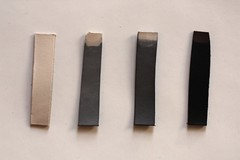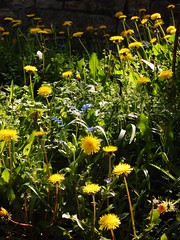
Vinegar black is an ancient technique for turning leather a dark grey or black colour. It was almost certainly discovered accidentally when iron was left to stand on leather, leaving black marks, but has been used by hobbyists and professional leather dyers ever since.
Vinegar black (or vinegaroon, as it was known in the Mid-West) is a simple affair - iron dissolved in vinegar is brushed on to leather, turning it black. The iron and vinegar react to make ferric acetate, which in turn reacts with the natural tannins in the leather to give a permanent black stain. As such it isn’t a dye, but a chemical reaction which is permanently bound with the leather. Of course, this means it will only work with vegetable tanned leather, which is rich in tannins. It does give off some particularly nasty smells during the reaction, but the neutralising process and a good airing removes this from the leather.
This process will of course only work on naturally tanned leather - also known as ‘veg tan’ - and not on any other chemically tanned or dyed leathers.
Recipe
2 litres White Vinegar
4-5 wads wire wool, or rusty metal nails
Half fill a jar with wire wool or other rusty metal, pour on vinegar to cover and close up the container - don’t seal it though as it can give off some gas which might make it expode!. Leave in a warm place for a week, until the liquid turns a brown tea-like colour.
Usage
Strain off the liquid to remove any small metal particles. Apply the liquid to veg-tan leather with a paintbrush, applying repeated coats if a darker colour is required. You can dip the leather in the liquid if its easier, but don’t soak it, as this may cause the leather to soften and change shape.
Wipe down with a wet cloth to remove any excess liquid, then neutralise. Only neutralise once the leather is about the right shade of black.
Neutralising
Mix 3tbsp of Bicarbonate of Soda (Baking Soda) with 1 litre of warm water. Brush on, or dip the leather in this solution - it may fizz slightly as the soda neutralises the vinegar.
Once complete, rinse well or immerse in fresh water to remove any remaining traces of vinegar or soda from the leather, which could continue to eat away at the leather and cause damage.
The leather may still have a slight smell of vinegar, but this will disappear with time, especially once the leather has dried completely.
When dry you should treat the leather with some kind of oil to prevent it becoming dry and brittle, which can happen in some cases as the treatment can strip some of the natural oils out of the leather.
Read more...



